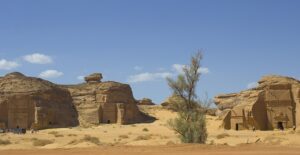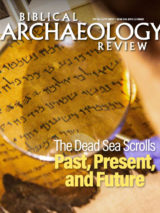Jews in Pre-Islamic Arabia
Tracing the Jewish diaspora in ancient North Arabia

Rock-cut tombs at Madain Saleh, ancient Hegra of pre-Islamic Arabia. Photo: Basheer Olakara, CC BY 2.0, via Wikimedia Commons.
In the first two centuries CE, Jews led two major revolts against the Romans—first, the Great Revolt (66–74), then the Bar-Kokhba Revolt (132–135). In their tragic aftermath, when the Temple lay in ruins and Jews were forbidden to live in or near Jerusalem, many decided to seek new homes abroad. Some from this early Jewish diaspora turned south and ended up in North Arabia, where only inscriptions survive to bear witness to individuals who clearly belonged to the scattered Jewish communities of pre-Islamic Arabia.
In his article “Jews of Arabia: Ancient Inscriptions Reveal Jewish Diaspora,” published in the Fall 2024 issue of Biblical Archaeology Review, Gary A. Rendsburg explores a set of ancient inscriptions that reveals the presence of a Jewish diaspora at the major oases of North Arabia. Rendsburg, who is a professor of Jewish Studies and History at Rutgers University and has extensively published on the Hebrew language and literature, focuses on inscriptions from four major sites that illustrate the range of testimonies these silent witnesses can deliver about the long-lost Jewish diaspora of pre-Islamic Arabia.

FREE ebook: Ancient Israel in Egypt and the Exodus.
“In the main, we have only the names of Jewish individuals, but here and there more pertinent information surfaces, including their high rank in society, their worship of the one God, their use of the term “rabbi,” and their observance of Passover,” writes Rendsburg.
At Madain Saleh (ancient Hegra), which features stunning rock-cut tombs (see photo above), a funerary inscription was found written in Aramaic using Nabatean script. Dated to 356, it reads, in part: “This is [the tomb] which Ady[on] son of Honi son of Samuel, chief citizen (ryš) of Hegra, [erected] for Mawyah his wife, daughter of Amru son of Adyon son of Samuel, chief citizen (ryš) of Tayma.” Honi and Samuel in this inscription are Hebrew names identifying the persons as Jewish. Even more interesting, the two families clearly climbed to the highest ranks of their respective communities.
Another example comes from Tayma, where an Aramaic tomb inscription was similarly written in Nabatean script. Dated to 203, it mentions four people, three of which were apparently Jewish, judging by their personal names: Isaiah, Joseph, and Amram. Remarkably, one of these individuals served as city councilor, and another one was the city mayor. “Undoubtedly, the family would have settled in Tayma at least a generation or two earlier, in time to allow its scions to rise in the ranks of the local society. Thus, we may posit a scenario whereby the ancestors of this family moved to Tayma soon after or possibly even some years before the Bar-Kokhba Revolt,” theorizes Rendsburg.

FREE ebook: Exploring Jordan: The Other Biblical Land. Delve into a legendary land rich with Biblical history.

A tomb inscription from Tayma oasis commemorates “Isaiah, the councilor, son of Joseph, the mayor of Tayma.” Photo: Nesnad, CC-BY-4.0, via Wikimedia Commons.
“Clearly the Jews (and Christians) of the Hejaz exerted a major influence on Muhammad, as he broke with the polytheism of Arabia to establish a new religious path. How the former group reached the region and how they sustained themselves in the lead-up to the rise of Islam has remained an open question,” concludes Rendsburg. Fortunately, ancient inscriptions allow us at least a minor window into that fascinating world.
To learn more about these and other ancient inscriptions and what they reveal about the early Jewish diaspora in pre-Islamic Arabia, read Gary A. Rendsburg’s article “Jews of Arabia: Ancient Inscriptions Reveal Jewish Diaspora,” published in the Fall 2024 issue of Biblical Archaeology Review.
Subscribers: Read the full article “Jews of Arabia: Ancient Inscriptions Reveal Jewish Diaspora” by Gary A. Rendsburg in the Fall 2024 issue of Biblical Archaeology Review.
Not a BAS Library or All-Access Member yet? Join today.
Related reading in Bible History Daily:
All-Access members, read more in the BAS Library:
Jesus in Arabia: Tracing the Spread of Christianity into the Desert
Paul of Arabia? The Apostle’s Early Adventures
Archaeology Thriving in Saudi Arabia
Not a BAS Library or All-Access Member yet? Join today.
Must-Read Free eBooks
Want more Bible history?
Sign up to receive our email newsletter and never miss an update.
Unlock Unlimited Access to the Bible's Past
Become an All-Access Member to explore the Bible's rich history. Get Biblical Archaeology Review in print, full online access, and FREE online talks. Plus, enjoy special Travel/Study discounts. Don't miss out—begin your journey today!











